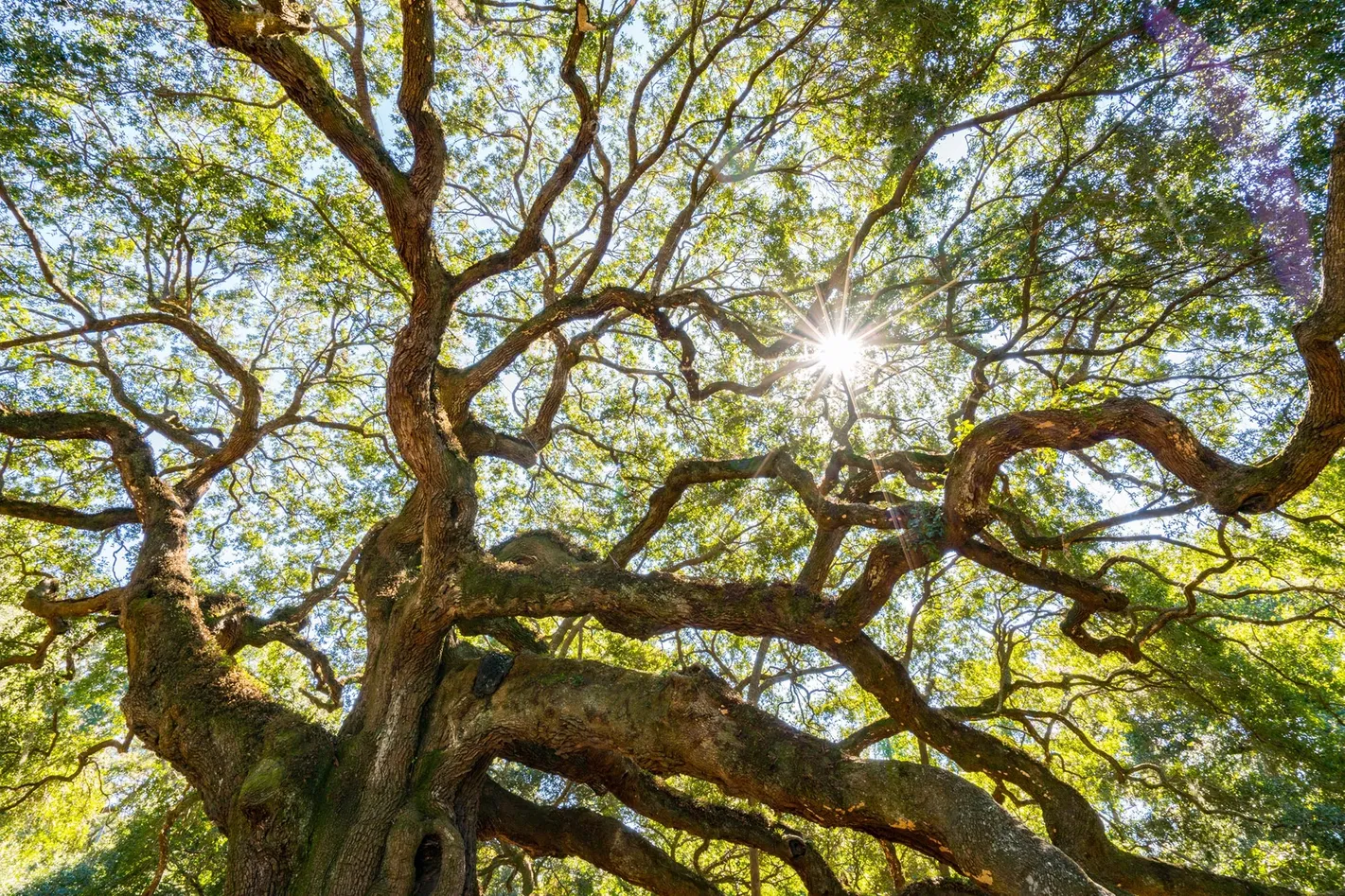
Avec un peu de chance, le Quercus tardifolia solitaire sera ramené à la santé et soigné comme le Chêne de l’Ange, photographié ici.
Un Quercus tardifolia s’accroche à la vie dans le parc national de Big Bend.
Des chercheurs en botanique ont découvert un chêne que l’on croyait éteint et qui a besoin d’être conservé dans le parc national de Big Bend au Texas. La découverte a été faite par des scientifiques représentant une coalition de plus de 10 institutions.
Les scientifiques dirigés par le Morton Arboretum et le United States Botanic Garden (USBG) ont été enthousiasmés par la découverte d’un spécimen solitaire d’un arbre de la famille de l’arbre. Quercus tardifolia (Q. tardifolia) d’environ 30 pieds (9 mètres) de haut, bien qu’il soit en mauvaise santé. Décrit pour la première fois dans les années 1930, le dernier spécimen vivant connu aurait péri en 2011.
“Ce travail est crucial pour préserver la biodiversité que la Terre perd si rapidement”, a déclaré Murphy Westwood, Ph.D., vice-président de la science et de la conservation à l’Institut de recherche de l’Université d’Ottawa. L’Arboretum de Morton. ” Si nous ignorons le déclin de Q. tardifolia et d’autres arbres rares et menacés, nous pourrions assister à d’innombrables effets domino avec la perte d’autres entités vivantes dans les écosystèmes soutenus par ces arbres”, a-t-elle déclaré. Selon Westwood, Q. tardifolia est considéré comme l’un des chênes les plus rares du monde, si ce n’est le plus rare.
Les chercheurs espèrent qu’en déterminant les raisons de l’extinction de cet arbre, ils seront en mesure de protéger d’autres organismes du même sort. Malheureusement, il n’est toujours pas clair si ce spécimen de Q. tardifolia peut être sauvé.

Le groupe de chercheurs avec le seul spécimen de Quercus tardifolia. Crédit : United States Botanic Garden
Le 25 mai 2022, l’équipe de chercheurs a fait la découverte, mettant au jour une scène désastreuse. Le tronc de l’arbre est marqué par le feu et présente des signes d’une grave infection fongique. Une sécheresse ou un incendie pourrait mettre fin à sa vie, selon les scientifiques, qui signalent également que le changement climatique rend cette issue de plus en plus probable chaque année. Le groupe travaille actuellement avec le National Park Service afin de réduire la menace immédiate d’incendie de forêt qui pèse sur l’arbre. En outre, les défenseurs de l’environnement participant à cette collaboration s’empressent de retourner à la recherche de glands et de tenter la propagation, c’est-à-dire la reproduction de spécimens à partir d’une plante mère.
“Il s’agit d’une recherche importante, menée en collaboration, nécessaire à la conservation de l’espèce. Q. tardifoliaa déclaré Carolyn Whiting, botaniste au parc national de Big Bend. Les montagnes Chisos abritent une grande diversité d’espèces de chênes, en partie en raison de la grande variété d’habitats disponibles dans cette “île du ciel”. Il y a encore beaucoup à apprendre sur les chênes des Chisos. “
“Le Jardin botanique des États-Unis est ravi du succès de ce partenariat et de ce voyage de collecte qui a permis de redécouvrir un chêne aussi rare”, a déclaré Susan Pell, Ph.D., directrice exécutive par intérim du Jardin botanique des États-Unis. United States Botanic Gardenqui finance le projet et y collabore. “Cette découverte n’est que le début du travail de conservation que nous effectuons en partenariat avec The Morton Arboretum pour mieux comprendre et conserver les arbres menacés.”
Parmi les autres collaborateurs de ce projet, citons Bartlett Tree Research Laboratories and Arboretum ; Lady Bird Johnson Wildflower Center ; NatureServe ; Polly Hill Arboretum ; San Antonio Botanical Garden ; University of California, Davis Arboretum and Public Garden ; et The Sul Ross State University A. Michael Powell Herbarium.

Des chercheurs cherchent dans l’arrière-pays du parc national de Big Bend. Crédit : Photo par Bartlett Tree Research Laboratories and Arboretum.
Que pourrait révéler l’analyse moléculaire sur Quercus tardifolia ?
Les chênes ont tendance à s’hybrider, ou à se croiser, ce qui peut leur permettre de s’adapter plus rapidement aux conditions climatiques changeantes telles que les chaleurs extrêmes et les nouvelles maladies. Cette hybridation fréquente peut également brouiller les lignes génétiques entre les espèces de chêne dans un écosystème donné comme Big Bend. L’analyse moléculaire confirmera si le DNA of the newly discovered tree matches that of previous samples of Q. tardifolia, but according to the researchers, there is a chance that the analysis will raise more questions than answers.
According to Andrew Hipp, Ph.D., senior scientist in plant systematics and herbarium director at The Morton Arboretum, whose team will be conducting the genetic analysis, “This is an interesting problem. We’re looking into whether this tree is genetically similar to other trees that have been previously collected as Q. tardifolia. That should tell us whether this collection is the same as what Cornelius H. Muller named Q. tardifolia. It should also tell us whether this collection of specimens is genetically distinct enough from other closely related oaks in the area to warrant recognition as a species.”
Regardless of classification, Hipp noted that it is important to preserve more than individual species, but rather all the genetic variation in life. “Species are genetically distinct populations that we can generally recognize in the field,” he said. “But they aren’t the be-all and end-all of conservation. We also aim to protect the functional variation within species. Leaf forms, physiological responses to drought and fire and even tree longevity are all attributes that can be shared among populations and among species by gene flow. The functional variation that these new collections represent may be just what is needed to help oaks of the region adapt to environmental changes in the near or distant future.”

Quercus tardifolia leaves. Credit: Photo by Bartlett Tree Research Laboratories and Arboretum
Preserving oaks is critical to ecosystems
Oaks are exceptional among tree species in that their acorns cannot be traditionally seed banked for conservation purposes. According to the researchers, they must be preserved in the wild or in living collections, which is why the involvement of botanical gardens is critical. The researchers who found the Q. tardifolia tree are concerned that it is not producing acorns. Other methods of propagation, including grafting, are being pursued to preserve the oak’s future.
“Across the planet, oaks serve as an ecological anchor cleaning air, filtering water, sequestering carbon dioxide and supporting countless fungi, insects, birds and mammals,” Westwood explained. “When one is lost, we don’t know what else we might permanently lose in its wake,” she said.
However, Westwood, Pell and others warn that conservation efforts such as this require collaborative initiatives, such as the Global Conservation Consortium for Oak, the involvement of botanical gardens and a variety of scientific experts to secure a future for endangered trees.
“In many ways, this tree is an ancient relic. Due to the changing climate, the world is completely different now than when it evolved,” said Wesley Knapp, chief botanist at NatureServe, who participated in the expedition. “It is incumbent upon us to learn from it and protect it while we still can in order to inform future conservation efforts,” he said. “Nature rarely hands us a second chance, and I doubt we’ll get a third. We won’t waste it.”
Members of the May 2022 expedition that first located the lone Q. tardifolia tree included Adam Black of Bartlett Tree Research Laboratories and Arboretum, Michael Eason of San Antonio Botanical Garden, Emily Griswold of UC Davis Arboretum and Public Garden, Wesley Knapp of NatureServe, John Saltiel of USBG, Phillip Schulze of Lady Bird Johnson Wildflower Center, Elizabeth Thomas of Polly Hill Arboretum, Kelsey Wogan of Sul Ross State University A. Michael Powell Herbarium and Zarah Wyly, an independent oak researcher in California.
About The Morton Arboretum
The Morton Arboretum is a world-renowned leader in tree science and research. Its 1,700-acre site includes 222,000 tree and plant specimens, representing 4,650 taxa from 40 countries. The Arboretum’s Center for Tree Science collaborates with researchers around the world, contributing scientific knowledge and technical experience to secure the future of trees. The Arboretum’s Global Tree Conservation Program leverages the expertise of the botanical garden community to protect and restore vulnerable and threatened trees. Additional information about the Arboretum’s scientific work and how it contributes to a greener, healthier world for future generations can be found at mortonarb.org.
About the United States Botanic Garden
The United States Botanic Garden (USBG) is the oldest continuously operating public garden in the United States, created by Congress in 1820. The USBG informs visitors about the importance and fundamental value and diversity of plants, as well as their aesthetic, cultural, economic, therapeutic, and ecological significance. With over a million visitors annually, the USBG strives to demonstrate and promote sustainable practices. It is a living plant museum accredited by the American Alliance of Museums and Botanic Gardens Conservation International.


![Explorer la Terre depuis l'espace : fleuve Mackenzie, Canada [Video]](https://7zine.com/wp-content/uploads/2021/10/1633269717_Explorer-la-Terre-depuis-lespace-fleuve-Mackenzie-Canada-Video-380x250.jpg)
